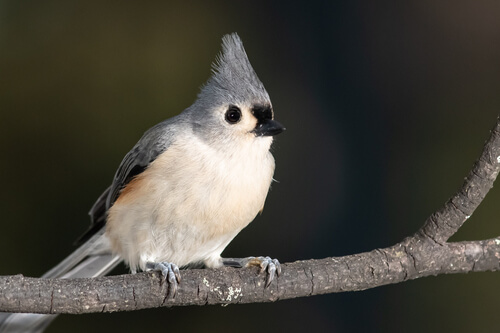
| Kingdom | Animalia |
| Phylum | Chordata |
| Class | Aves |
| Order | Passeriformes |
| Family | Paridae |
| Genus | Baeolophus |
| Species | B. bicolor, B. atricristatus |
| Niche | Non-migratory songbird |
| Length | 5.9-6.7 in (15-17 cm) |
| Weight | 0.04 lbs (21 g) |
| Lifespan | 2.1 years |
| Social Structure | Pairs or small flocks |
| Conservation Status | Least concern |
| Preferred Habitat | Deciduous forests, nesting in tree cavities |
| Average Clutch Size | 5-7 eggs |
| Main Food Items and Prey | Seeds, insects (caterpillars, beetles, ants, wasps, etc.) |
| Predators | Cats, birds of prey, snakes, raccoons, skunks, opossums, squirrels |
The Basics
The titmouse refers to two distinct species of birds of the genus Baeolophus. They are small songbirds native to North America and are members of the Family Paridae, which is comprised of tits and chickadees. The tufted titmouse (B. bicolor) and the black-crested titmouse (B. atricristatus) are considered separate species, although B. atricristatus was once thought of as a subspecies of B. bicolor.
These small birds are mostly grey with a white front with a rust-colored outline and a black forehead. They also have a characteristic tufted grey mohawk-like crest on their heads. They are approximately 6 inches (16 cm) long and weigh less than half a pound (21 g).
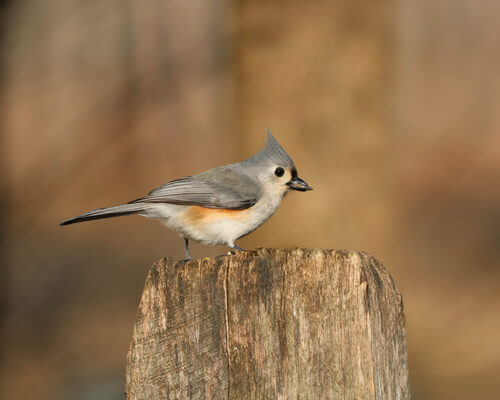
Titmice prefer deciduous forests and woodlands. Where humans have disrupted their natural habitat, they have also made use of gardens and parks. They spend most of their time in trees to avoid predators but will move to the ground to feed. Here, they will gather many different food items like berries, nuts, and seeds. They will also eat many different types of insects such as caterpillars and wasps, particularly in the summer when they are abundant. They are also regular visitors to bird feeders.
Nesting and Reproduction
Titmice females nest in holes or cavities in trees. They will also make use of nest boxes made by humans. They are not able to excavate tree cavities themselves, so have been known to use old woodpecker nests when they are unable to find a suitable and unoccupied nesting site of their own.
Males and females both work to line the nest with soft materials and even like to use hair or fur from animals including family pets like domestic dogs. Titmice are also known to use shed snake skins as well, which may act as a predator deterrent.
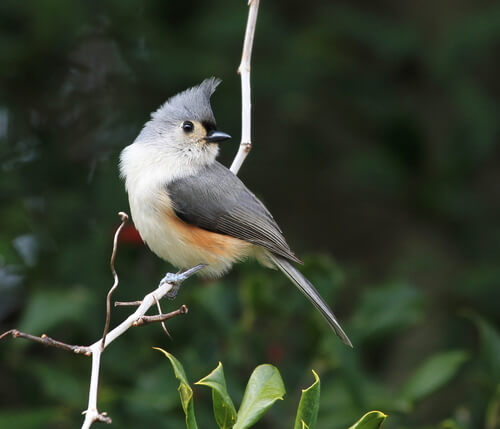
Females lay their clutch of about 5-7 small eggs. These are about 1 inch (2.5 cm) long and are white or cream-colored with darker brown or purple spots. Fascinatingly, titmice fledglings that have recently left the nest will often help the parents raise the next year’s young.
Their eggs and young are vulnerable to predators like snakes, raccoons, and skunks that may invade titmouse nests. But like many songbirds, one of their primary predators is the domestic cat. Adult titmice are also vulnerable to birds of prey such as Hawk and Falcon. Consequentially, their average lifespan in the wild is about 2.1 years. However, it is possible for them to live for more than 10 years.
Since the 1960s, the tufted titmouse population has been growing at about 1.5% per year. During this time, they have proliferated throughout much of the USA due largely to their success in human-developed areas which generally threaten most wild species. Thus, their populations are strong and titmice are listed as “Least Concern” by the IUCN.
Fun Facts about the Titmouse!
The titmouse is energetic and charismatic. Their tufted crest makes them distinctive, but that’s not all that makes them memorable.
Song
Songbirds are known for the pleasant melodies they tend to whistle from their perches. The titmouse is no exception. Its song is vibrant and diverse. In fact, it varies in about 20 different ways.
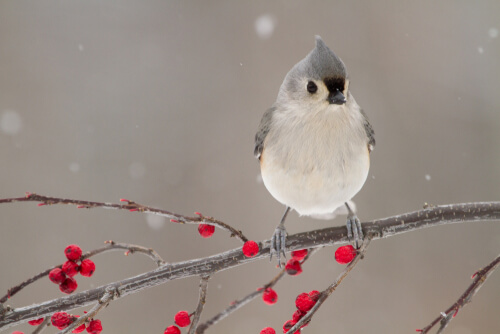
Typical titmouse songs are repetitive or chant-like. A quickly whistled peter peter peter or here here here with different parts of the song at lower pitches, for example. Songs vary in frequency from just one to up to 35 songs per minute. They sing most commonly during the breeding season, presumably while communicating and courting.
Neighboring titmice seem to reply with the same songs as they hear, indicating that they may share and learn songs in this way. In fact, despite learning songs from their family at a young age, juvenile titmice will often take up the songs of their neighbors in their adult territory.
A Homebody
Unlike many other North American songbirds that migrate from the north in the summer to a more southerly location such as Mexico in the winter, titmice are non-migratory. As a species they are quite widespread, having moved across the United States and into parts of Canada from their native Mississippi and Ohio. However, individual birds are non-migratory. Instead of relocating to avoid foul weather, their range simply tends to fall within areas that don’t experience extreme conditions. Therefore, they don’t need to move far if at all to avoid the cold.
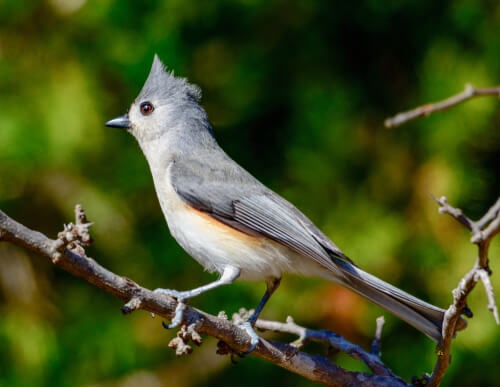
Killer Cats
Of all the threats of the natural world, one of the biggest threats to songbirds such as the titmouse is domestic cats. In fact, cats are among the leading causes of mortality for songbirds along with habitat destruction for human development. Cats kill approximately 1-4 billion songbirds per year in the United States alone!
